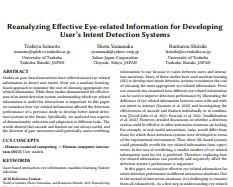IPLAB
Interactive Programming Laboratory.

Reanalyzing Effective Eye-related Information for Developing User’s Intent Detection Systems
Toshiya Isomoto, Shota Yamanaka, Buntarou Shizuki
Studies on gaze-based interactions have utilized natural eye-related information to detect user intent. Most use a machine learning-based approach to minimize the cost of choosing appropriate eye-related information. While those studies demonstrated the effectiveness of an intent detection system, understanding which eye-related information is useful for interactions is important. In this paper, we reanalyze how eye-related information affected the detection performance of a previous study to develop better intent detection systems in the future. Specifically, we analyzed two aspects of dimensionality reduction and adaptation to different tasks. The results showed that saccade and fixation are not always useful, and the direction of gaze movement could potentially cause overfitting.Reanalyzing Effective Eye-related Information for Developing User's Intent Detection Systems
References
- Toshiya Isomoto, Shota Yamanaka, Buntarou Shizuki, Reanalyzing Effective Eye-related Information for Developing User’s Intent Detection Systems, In Proceedings of the 2023 ACM Symposium on Eye Tracking Research & Applications (ETRA 2023), Eyes4ICU, Article 71, May 30-June 2, 2023, Tubingen, Germany, Association for Computing Machinery, pp. 1-3, DOI: https://doi.org/10.1145/3588015.3589508